

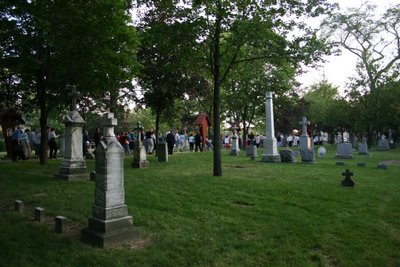
Sacred Heart 2006 - Post 1
Sacred Heart 2006 - Post 2
Sacred Heart 2006 - Post 3
Sacred Heart 2006 - Post 4
Sacred Heart 2006 - Post 5
Sacred Heart 2006 - Post 6





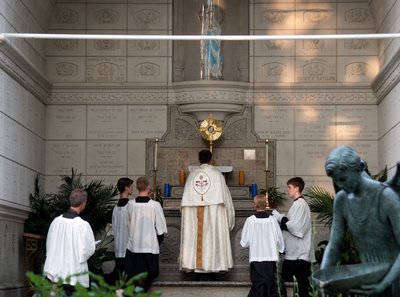
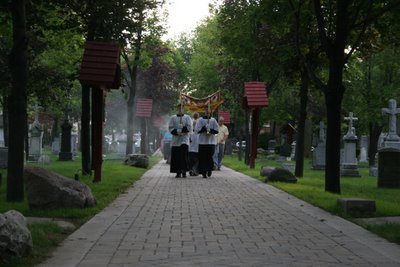
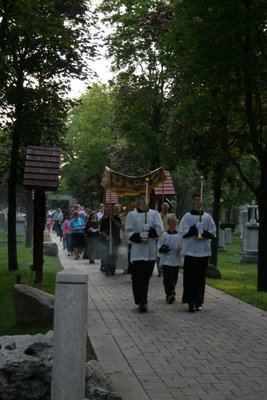



What followed 7:00pm holy Mass, was Benediction, then a procession to the large outdoor Grotto, as we do on all good-weather, summer Sundays following our 9:30am.
I'm going to stop here for the photo of the day, and bring more pictures from the Feast of the Sacred Heart in later posts. I want to focus on this for a moment. Note the priest bowing as he kneels. We had just begun the Tantum Ergo and I would like to highlight this "Sacred Moment".
From New Advent, the online Catholic Encyclopedia:
TANTUM ERGO
The opening words of the penultimate stanza of the Vesper hymn (see PANGE LINGUA GLORIOSI, II) of Corpus Christi. This stanza and the closing one, or doxology ("Genitori" etc.), form a separate hymn which is prescribed for Benediction of the Blessed Sacrament (q.v.).
In private exposition, where permission has been obtained to give benediction with the pyx, the two stanzas are recited by the priest (or sung by a choir, if this is feasible: "si fieri potest, optandum est", says Van der Stappen). In other expositions they must always be sung. Customs vary in respect of the method of singing. In some places the choir sings the two stanzas; in others, the celebrant sings the opening words of each stanza, the choir continuing. The Ritual (Tit. IX, c.5) speaks of all the clergy present singing the stanzas, and Scholber (Caeremoniae missarum solemnium et pontificalium), commenting on this, suggests that either the celebrant and assisting clergy should intone the first line of the stanza, or the choir alone should sing both stanzas. A profound inclination of the head is made at the words "veneremur cernui" (Wapelhorst). The "American Ecclesiastical Review" (XXI, 1889, 644) points out that the rubrics do not prescribe an inclination of the head at the words "veneremur cernui", although the practice is frequent. Gardelllini, in his "Commentary on the Clementine Instruction" (XXIV, 9-10), cites the custom of the churches of Rome; and the Rituals before his day make mention of the profound inclination at the Tantum ergo down to the word "cernui": "nam in verbo cernui completur dictionis sensus, qui inclinationem postulat".
Continue reading Tantum Ergo...
So, what we have is a pious custom and a good one I believe. When I noticed the priests doing this, it led me to ponder the words I had put to memory. What did they mean? I had seen the English on the facing page many times, but never bothered much, until now.
Here is the first stanza in Latin:
Tantum ergo Sacramentum
veneremur cernui:
et antiquum documentum
novo cedat ritui:
praestet fides supplementum
sensuum defectui
Here it is in English.
Down in adoration falling,
Lo! the sacred Host we hail;
Lo! o'er ancient forms departing,
newer rites of grace prevail;
faith for all defects supplying,
where the feeble sense fail.
Looking at the first two lines, I can understand why we would want to bow.

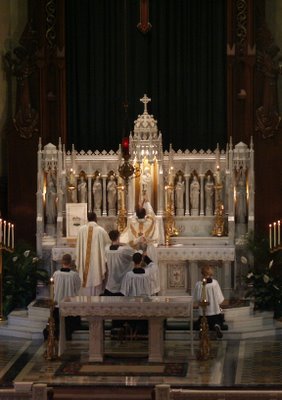
"....in atonement for our sins and those of the whole world."
More photos of Sacred Heart 2006 to come: The Procession outdoors, and the Benediction.
Sacred Heart 2006 - Post 1
Sacred Heart 2006 - Post 2
Domeeenay Yeyzoo Chwreestoo.
Dohmeeneh Yehzoo Chdddeesto.
There is then, a bow, and the altar boys proceed to work their way around the sanctuary, incensing other priests, then any other altar boys, before finally coming before the faithful gathered.


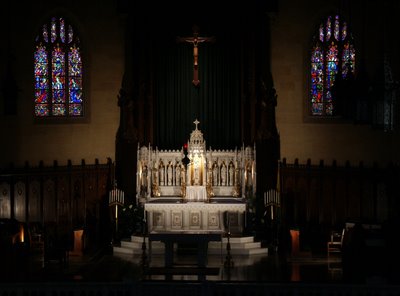
Mass begins. The celebrant is wearing the Sacred Heart on his vestment.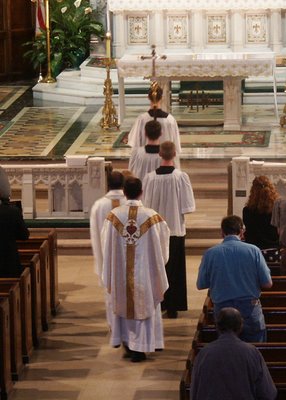
"Et incarnatus est..." Bowing is explained in a previous post.
Altar boys assisting the priest as we head into the Eucharistic Prayer.
More pictures tomorrow or Sunday, including the ever-beautiful, "Elevation". We were blessed to have Benediction outdoors, just as we do on Sundays, but it was geared towards the Sacred Heart. I'll be bringing pictures of that, as well, in the coming days.
I should probably have mentioned that if you ever come to an evening feast day Mass, it is likely going to be celebrated mostly, or partially, in Latin. If you are not aquainted with Grotto, there are little gray Mass booklets which guide you through the Mass, and solid translations are on the opposite page. If you see a little, white, rectangular basket on the altar rail near the center on either side, they are in there, and sometimes on the stand where the gifts are placed in the center aisle. Follow along as it can be an eye-opening experience if you glance back and forth at the good translations on the facing page as you read the Latin.
I must admit, that the words of the Eucharistic prayers used (there are 4), but I have never paid attention to them, until I started attending the Latin Mass and reading along, while glancing at the opposite page. Soon you start to connect certain words with meanings, as well. But, I began to dive deeper into the Mass, aided by the need to read what was going on.
I can understand how some would prefer not to have to work so hard to know what is going on and have everything in the vernacular. However, can you imagine being in an international setting, with dozens of ethnicities and nationalities present, all capable of singing the Pater Noster in Latin?
Jesus heading towards the Church
If you wonder how there can be prayers said and songs sung in unison with hundreds of people outdoors - here you go: Two guys and two remote speakers, strategically positioned as we moved from altar to altar. Thanks guys!
Jesus enters the Church!

O God, my God, to thee do I watch at break of day. For thee my soul hath thirsted; for thee my flesh, O how many ways! 3 In a desert land, and where there is no way, and no water: so in the sanctuary have I come before thee, to see thy power and thy glory.
And today is the Feast of the Sacred Heart of Jesus, so we especially pray that last one today!
I haven’t been saying the words all my life.
Just 16 of my 35 years.
Hmmm… "Charity, Joy, Peace, Patience…." etc. Just savor that word "devout" here. That provides justification for all the emotion that follows.But I am as confused, disappointed and, well, angry, as any devout Roman
Catholic I know.
Mass is the starting point for my week. A renewal that I participate in. The
words, the music, the people - they ground me.

Benediction at the fourth outdoor altar!
The Knights carrying the canopy did not want to step on the elaborate decoration made by the sisters, but pastor, Fr. Perrone, waved them to go ahead and do what they had to get Jesus back "under the tent".
Jesus is heading back to Church from the fourth outdoor altar.
Jesus "waits" as all the faithful gathered at the fourth outdoor altar, move on ahead, processing before Him into the Church.
Note one altar boy facing the Blessed Sacrament as he incenses, while the other is facing forward - a continuous process through the route.
More pictures tomorrow, if Blogger cooperates!
Members, I would like to introduce you to a new friend and hero of mine -- her
name is Gianna Jessen. She is visiting us today from Nashville, Tennessee, where
she is an accomplished recording artist.
She has cerebral palsy and was
raised in foster homes before being adopted at the age of four.
She was
born prematurely and weighed only 2 pounds at birth. She remained in the
hospital for almost three months. A doctor once said she had a great will to
live and that she fought for her life. Eventually she was able to leave the
hospital and be placed in foster care.
Because of her cerebral palsy,
her foster mother was told that it was doubtful that she would ever crawl or
walk. She could not sit up independently. Through the prayers and dedication of
her foster mother, she eventually learned to sit up, crawl, then stand. Shortly
before her fourth birthday, she began to walk with leg braces and a walker.
She continued in physical therapy and after a total of four surgeries,
she was able to walk without assistance.
She still falls sometimes, but
she says she has learned how to fall gracefully after falling for 29 years.
Two years ago, she walked into a local health club and said she wanted a
private trainer. At the time her legs could not lift 30 pounds. Today she can
leg press 200 pounds.
She became so physically fit that she began
running marathons to raise money and awareness for cerebral palsy. She just
returned last week from England where she ran in the London Marathon. It took
her more than eight-and-a-half hours to complete. They were taking down the
course by the time she made it to the finish line. But she made it, nonetheless.
With bloody feet and aching joints, she finished the race.
Members would you help me recognize a modern-day hero -- Gianna Jessen?
Mr. Speaker, members, if you would allow me just a few more moments I would appreciate your time.
My name is Ted Harvey, not Paul Harvey, but, please, let me tell you the rest of the story.
The cause of Gianna's cerebral palsy is not because of some biological freak of nature, but rather the choice of her mother.
You see when her biological mother was 17-years-old and 7-and-a-half months pregnant, she went to a Planned Parenthood clinic to seek a late-term abortion. The abortionist performed a saline abortion on this 17-year-old girl. This procedure requires the injection of a high concentration of saline into the mother's womb, which the fetus is then bathed in and swallows, which results in the fetus being burned to death, inside and out. Within 24 hours the results are normally an induced, still-born abortion.
As Gianna can testify, the procedure is not always 100 percent effective. Gianna is an aborted late-term fetus who was born alive. The high concentration of saline in the womb for 24 hours resulted in a lack of oxygen to her brain and is the cause of her cerebral palsy.
Members, today, we are going to recognize the 90th anniversary of Rocky Mountain Planned Parenthood…"